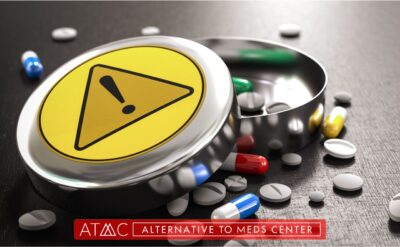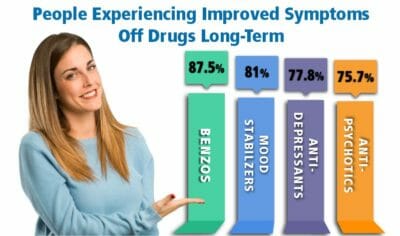Last Updated on May 14, 2025 by
Alternative to Meds Editorial Team
Medically Reviewed by Dr Samuel Lee MD
Last Updated on May 14, 2025 by
Alternative to Meds Editorial Team
Medically Reviewed by Dr Samuel Lee MD
Most medications are not completely understood as to how they impact the human body. This is an amazingly overlooked fact. Theories and conjecture and even untruths have enabled drug regulators to approve many drugs, while not actually understanding their mechanisms. What IS known, however, is that many drugs are linked to resulting neurological issues that can possibly be resolved once the drug is withdrawn.2
The term “encephalopathy” means brain damage whether it is caused by a disease, a toxin, a drug, genetic factors, or other causes. Researchers show that MANY drugs and toxins can cause encephalopathy.29
 The following are some of the drugs are known to cause neurological issues:
The following are some of the drugs are known to cause neurological issues:
(Please scroll down for more info on each drug listed here.)

Benzodiazepines are a central nervous system depressant, or sedative. This group of drugs, including Xanax (alprazolam), Klonopin (clonazepam), Ativan (lorazepam), Valium (diazepam), and others, is commonly used for treating short-term anxiety, panic attacks, and muscle spasms, and can be used to help with alcohol withdrawal. However, benzodiazepine drugs are often overprescribed far longer than the several weeks maximum that drug regulators have advised. Long-term use can cause debilitating damage to the brain and nervous system.4
While benzodiazepines are the primary group of sedatives used today, there are other drugs used to treat conditions like anxiety and insomnia. Central nervous system depressants include barbiturates like Luminal (phenobarbital) and insomnia drugs (or “Z-drugs”) like Ambien and Lunesta. Sedatives work similarly to alcohol — they interfere with neurotransmitters to decrease certain nervous and cognitive functions. As a result, sedatives can provide feelings of calm and euphoria in addition to inducing sleep.
After taking a sedative, individuals may experience several side effects such as slurred speech, inability to concentrate, headache, dizziness, confusion, hallucinations, slow breathing, low blood pressure, nightmares, paranoia, and mild euphoria.
When taken long-term, researchers have noted that sedatives can cause neurological issues such as memory impairment, attention and concentration issues, decreased executive function, and risk of early onset of dementia.5,13,25
Opioid painkillers derived from the poppy plant or its analogs, are helpful for treating pain. Prescription opioids are also used to treat conditions as wide-ranging as severe cough to diarrhea.
Examples of prescribed opiates include Hydrocodone, oxycodone, oxymorphone, morphine, codeine, and fentanyl. All opioids are highly addictive and can quickly cause dependence and other side effects even when taken as prescribed.
When taken for prolonged periods, opioids can have uncomfortable and sometimes serious side effects, including feeling tired, drowsy, confused, nauseous, constipated, or euphoric. Misusing opioids can lead to slower breathing, which can result in hypoxia (too little oxygen reaching the brain). Hypoxia may lead to short-term or long-term neurological effects, such as a coma, permanent brain damage, or death. Studies have demonstrated that physical and chemical changes in the brain caused by opioids can also lead to a lowered seizure threshold, increased pain sensitivity, sleep disturbances, and hormonal imbalances.6
Amphetamines are not only potent stimulants, they are neurotoxic. They are also highly addictive and associated with a wide range of side effects including psychosis, insomnia, euphoria, loss of appetite, and many others.7
Selective serotonin reuptake inhibitors (SSRIs) and other types of antidepressants, such as amitriptyline can cause side effects like nausea, dizziness, sleep issues, and fatigue throughout the course of treatment. These drugs can lead to functional neurological disorders as these symptoms linger and may become permanent. Some antidepressants can cause NMS (neuroleptic malignant syndrome), and serotonin syndrome. Both of these conditions are potentially life-threatening, with symptoms of confusion, high fever, muscle rigidity, increased heart rate, coma, and others.8,27,29,30
Antipsychotics serve their purpose well in managing acute mania, psychosis, and schizophrenic symptoms. However, their clinical history is plagued by imperfect diagnoses, and unnecessarily long-term use. Research over many decades has documented the link between antipsychotics and undesirable neurological issues such as NMS, seizures, stroke, and other major complications, and equally so or even worse, when trying to withdraw from them.9-12
Research on alcohol related brain damage has documented the devastating neurological issues associated with chronic alcohol use, including amnesia, damage to brain structure, schizophrenic symptoms, and many others. Safe withdrawal from alcohol must be done in a supervised, medical setting due to the high risk of seizure and potential death if not managed properly.18
Most notably after long-term use, and addiction, a wide range of neurological issues are linked to drugs, medications, and alcohol.4,6,8,14,15,20,25,28
 Drug-induced neurological issues can include:
Drug-induced neurological issues can include:
According to the WHO, stroke is the second leading cause of death and disability in today’s world.10 Drugs known to contribute to increasing the risk of stroke include antipsychotics, and long-term or high dosage benzodiazepines.11,12
Dementia includes many neurological issues that involve degenerative cognitive function. A common symptom is poor memory, which progresses into inability to speak or process what is being said, inability to concentrate, inability to make decisions or plans, and poor visual-spatial capabilities.
According to broad research published in the 2022 British Medical Journal it was found that of 744 medications studied, one third of these prescription medications were linked to dementia.
The medications referenced in the study include benzodiazepines, sleeping pills, opiates and other pain pills, drugs used for quitting smoking, and many other classes of medications.13,25
Seizures are another neurological issue that can result from both pharmaceutical and street drugs. Seizures occur with an electric burst or other electrical disruption within the brain. Seizures disrupt processing thoughts, awareness, memory, muscle control, and movement. When a seizure happens, a person may stare into space, go limp, or start jerking or convulsive motions. Alcohol use disorder has a definite link to incidence of seizures. Drugs that can cause high or low blood sugar, high or low sodium plasma levels, or lack of oxygen from depressed respiration or heart rate, or sleep deprivation are all linked to seizure activity. Benzodiazepine withdrawal and alcohol withdrawal can cause seizures if not managed properly.31,32
Among the drugs most responsible for inducing seizures are the antidepressants and antipsychotics, including escitalopram (Cymbalta), bupropion (Wellbutrin), clozapine (Clozaril), quetiapine (Seroquel), and many others.14
Seizures have occurred in cases of opioid withdrawal, and a synthetic opioid called Tramadol lowers the threshold for seizures according to clinical research.31
Stimulant drugs such as the amphetamines, ecstasy, and cocaine cause seizures. Withdrawing abruptly from certain substances, such as alcohol or benzodiazepines, can result in serious seizures, which can sometimes be fatal.15
Ataxia is a condition of the central nervous system in which individuals experience trouble with coordination and movement. Drugs and toxins can injure the parts of the brain that control these functions. Those so affected may appear drunk, with slurred speech, may fall or stumble, or appear uncoordinated. These symptoms occur due to damage to the cerebellum, the part of the brain that controls movement.9,28,33
Encephalopathy (brain damage, malfunction, or disease) can result from structural damage, lesions, or other causes such as poor oxygen supply to the brain. In drug-induced cases, the damage done to the brain may be reversed by safely withdrawing from the drug. However, in some cases, there is too much damage that limits recovery. Additionally, encephalopathy can occur from the use or overuse of drugs that affect the function of the vital organs, cause chronic disturbances of consciousness, memory loss, uncontrolled seizures, personality changes and many other symptoms. 29
Drugs that are linked to causing encephalopathy include antibiotics, alcohol, antipsychotics, anticonvulsants, opioids, lithium, benzodiazepines, and stimulants such as cocaine. Drug-induced encephalopathy has been linked to many drugs that slow breathing, limiting oxygen sent to the brain (hypoxia). Timely treatment when little or no oxygen has reached the brain is critical to avoid permanent neurological damage. In many cases, this and other types of neurological damage often reverses when the drug is correctly withdrawn.19,29
If you are currently taking prescription medications, you may be concerned about potential neurological issues. These frequently asked questions could help you determine whether you should seek alternative therapy.
Are you concerned about healing from or reducing the risks of drug-induced neurological issues? We’ve been working this problem for many years with much success. And we have established a great number of ways to safely and comfortably assist our clients to regain natural mental health. We apply extensive lab testing, orthomolecular medicine to correct the diet and restore nutrient deficiencies, environmental medicine to remove toxins, and safe tapering to come off the medications/drugs that could be contributing to neurological issues. You can call us for more information about the program, insurance coverage, length of program, or any other questions you may have and we will be happy to take the time to speak with you. Call today!
1. Firth J, Gangwisch JE, Borisini A, Wootton RE, Mayer EA. Food and mood: how do diet and nutrition affect mental wellbeing? BMJ. 2020 Jun 29;369:m2382. doi: 10.1136/bmj.m2382. Erratum in: BMJ. 2020 Nov 9;371:m4269. doi: 10.1136/bmj.m4269. PMID: 32601102; PMCID: PMC7322666. [cited 2024 Nov 21]
2. Raju, N. N.; Kumar, K. S. V. R. Naga Pavan; Nihal, Gyan1, (2022). Management of Medication-Induced Psychiatric Disorders. Indian Journal of Psychiatry 64(Suppl 2), S281-S291. [cited 2024 Nov 21]
3. Danborg PB, Valdersdorf M, Gøtzsche PC. Long-term harms from previous use of selective serotonin reuptake inhibitors: A systematic review. Int J Risk Saf Med. 2019;30(2):59-71. doi: 10.3233/JRS-180046. PMID: 30714974; PMCID: PMC6839490. [cited 2024 Nov 21]
4. Ritvo AD, Foster DE, Huff C, Finlayson AJR, Silvernail B, Martin PR. Long-term consequences of benzodiazepine-induced neurological dysfunction: A survey. PLoS One. 2023 Jun 29;18(6):e0285584. doi: 10.1371/journal.pone.0285584. PMID: 37384788; PMCID: PMC10309976. [cited 2024 Nov 21]
5. Siddiqui, T. G., Cheng, S., Gossop, M., Kristoffersen, E. S., Grambaite, R., & Lundqvist, C. (2020). Association between prescribed central nervous system depressant drugs, comorbidity and cognition among hospitalised older patients: a cross-sectional study. BMJ open, 10(7), e038432. https://doi.org/10.1136/bmjopen-2020-038432 [cited 2024 Nov 21]
6. Blackwood CA, Cadet JL. The molecular neurobiology and neuropathology of opioid use disorder. Curr Res Neurobiol. 2021;2:100023. doi: 10.1016/j.crneur.2021.100023. Epub 2021 Oct 14. PMID: 35548327; PMCID: PMC9090195.[cited 2024 Nov 21]
7. Berman SM, Kuczenski R, McCracken JT, London ED. Potential adverse effects of amphetamine treatment on brain and behavior: a review. Mol Psychiatry. 2009 Feb;14(2):123-42. doi: 10.1038/mp.2008.90. Epub 2008 Aug 12. Erratum in: Mol Psychiatry. 2010 Nov;15(11):1121. PMID: 18698321; PMCID: PMC2670101. [cited 2024 Nov 21]
8. Moncrieff J. Persistent adverse effects of antidepressants. Epidemiol Psychiatr Sci. 2019 Sep 23;29:e56. doi: 10.1017/S2045796019000520. PMID: 31543093; PMCID: PMC8061256. [cited 2024 Nov 21]
9. Haddad PM, Dursun SM. Neurological complications of psychiatric drugs: clinical features and management. Hum Psychopharmacol. 2008 Jan;23 Suppl 1:15-26. doi: 10.1002/hup.918. PMID: 18098217. [cited 2024 Nov 21]
10. Murphy SJ, Werring DJ. Stroke: causes and clinical features. Medicine (Abingdon). 2020 Sep;48(9):561-566. doi: 10.1016/j.mpmed.2020.06.002. Epub 2020 Aug 6. PMID: 32837228; PMCID: PMC7409792. [cited 2024 Nov 21]
11. Marto JP, Strambo D, Livio F, Michel P. Drugs Associated With Ischemic Stroke: A Review for Clinicians. Stroke. 2021 Oct;52(10):e646-e659. doi: 10.1161/STROKEAHA.120.033272. Epub 2021 Aug 18. PMID: 34404236. [cited 2024 Nov 21]
12. Huang WS, Muo CH, Chang SN, Chang YJ, Tsai CH, Kao CH. Benzodiazepine use and risk of stroke: a retrospective population-based cohort study. Psychiatry Clin Neurosci. 2014 Apr;68(4):255-62. doi: 10.1111/pcn.12117. PMID: 24829937. [cited 2024 Nov 21]
13. Wilkinson T, Schnier C, Bush K, Rannikmäe K, Lyons RA, McTaggart S, Bennie M, Sudlow CL. Drug prescriptions and dementia incidence: a medication-wide association study of 17000 dementia cases among half a million participants. J Epidemiol Community Health. 2022 Mar;76(3):223-229. doi: 10.1136/jech-2021-217090. Epub 2021 Oct 27. PMID: 34706926; PMCID: PMC8862053. [cited 2024 Nov 21]
14. Kumlien E, Lundberg PO. Seizure risk associated with neuroactive drugs: data from the WHO adverse drug reactions database. Seizure. 2010 Mar;19(2):69-73. doi: 10.1016/j.seizure.2009.11.005. Epub 2009 Dec 24. PMID: 20036167. [cited 2024 Nov 21]
15. Brown JW, Dunne JW, Fatovich DM, Lee J, Lawn ND. Amphetamine-associated seizures: clinical features and prognosis. Epilepsia. 2011 Feb;52(2):401-4. doi: 10.1111/j.1528-1167.2010.02924.x. Epub 2011 Jan 4. Erratum in: Epilepsia. 2011 Aug;52(8):1529. Fatovic, Daniel M [corrected to Fatovich, Daniel M]. PMID: 21314677. [cited 2024 Nov 21]
16. Genuis SJ. Toxic causes of mental illness are overlooked. Neurotoxicology. 2008 Nov;29(6):1147-9. doi: 10.1016/j.neuro.2008.06.005. Epub 2008 Jun 24. PMID: 18621076. [cited 2024 Oct 9]
17. Lane RJ, Routledge PA. Drug-induced neurological disorders. Drugs. 1983 Aug;26(2):124-47. doi: 10.2165/00003495-198326020-00002. PMID: 6349966. [cited 2024 Nov 21]
18. Zahr NM, Kaufman KL, Harper CG. Clinical and pathological features of alcohol-related brain damage. Nat Rev Neurol. 2011 May;7(5):284-94. doi: 10.1038/nrneurol.2011.42. Epub 2011 Apr 12. PMID: 21487421; PMCID: PMC8121189. [cited 2024 Nov 21]
19. Bhutta BS, Alghoula F, Berim I. Hypoxia. [Updated 2024 Mar 4]. In: StatPearls [Internet]. Treasure Island (FL): StatPearls Publishing; 2024 Jan-. Available from: https://www.ncbi.nlm.nih.gov/books/NBK482316/ [cited 2024 Nov 21]
20. Caplan RA, Zuflacht JP, Barash JA, Fehnel CR. Neurotoxicology Syndromes Associated with Drugs of Abuse. Neurol Clin. 2020 Nov;38(4):983-996. doi: 10.1016/j.ncl.2020.08.005. PMID: 33040873; PMCID: PMC7574350.[cited 2024 Nov 21]
21. Kharrazian D. Exposure to Environmental Toxins and Autoimmune Conditions. Integr Med (Encinitas). 2021 Apr;20(2):20-24. PMID: 34377090; PMCID: PMC8325494. [cited 2024 Nov 21]
22. Orisakwe OE. The role of lead and cadmium in psychiatry. N Am J Med Sci. 2014 Aug;6(8):370-6. doi: 10.4103/1947-2714.139283. PMID: 25210669; PMCID: PMC4158644. [cited 2024 Nov 21]
23. Pickering G, Mazur A, Trousselard M, Bienkowski P, Yaltsewa N, Amessou M, Noah L, Pouteau E. Magnesium Status and Stress: The Vicious Circle Concept Revisited. Nutrients. 2020 Nov 28;12(12):3672. doi: 10.3390/nu12123672. PMID: 33260549; PMCID: PMC7761127. [cited 2024 Nov 21]
24. Muscaritoli M. The Impact of Nutrients on Mental Health and Well-Being: Insights From the Literature. Front Nutr. 2021 Mar 8;8:656290. doi: 10.3389/fnut.2021.656290. PMID: 33763446; PMCID: PMC7982519. [cited 2024 Oct 9]
25. NIDA. 2011, July 1. Drugs and the Brain. [cited 2024, October 9]
26. Peters J, Staff NP. Update on Toxic Neuropathies. Curr Treat Options Neurol. 2022 May;24(5):203-216. doi: 10.1007/s11940-022-00716-5. Epub 2022 Apr 6. PMID: 36186669; PMCID: PMC9518699. [cited 2024 Nov 21]
27. Simon LV, Hashmi MF, Callahan AL. Neuroleptic Malignant Syndrome. [Updated 2023 Apr 24]. In: StatPearls [Internet]. Treasure Island (FL): StatPearls Publishing; 2024 Jan-. Available from: https://www.ncbi.nlm.nih.gov/books/NBK482282/[cited 2024 Nov 21]
28. Hafiz S, De Jesus O. Ataxia. [Updated 2023 Aug 23]. In: StatPearls [Internet]. Treasure Island (FL): StatPearls Publishing; 2024 Jan-. Available from: https://www.ncbi.nlm.nih.gov/books/NBK562284/[cited 2024 Nov 21]
29. Hansen Niels, Drug-Induced Encephalopathy, Julius-Maximilians University Warburg Department of Neurology, Germany [cited 2024 Nov 21]
30. Simon LV, Torrico TJ, Keenaghan M. Serotonin Syndrome. [Updated 2024 Mar 2]. In: StatPearls [Internet]. Treasure Island (FL): StatPearls Publishing; 2024 Jan-. Available from: https://www.ncbi.nlm.nih.gov/books/NBK482377/[cited 2024 Nov 21]
31. Furo H, Podichetty A, Whitted M, Zhou YY, Torres F, Brimhall BB. Association Between Opioid Use Disorder and Seizure Incidents Among Alcohol Use Disorder Patients. Subst Abuse. 2023 Jun 28;17:11782218231181563. doi: 10.1177/11782218231181563. PMID: 37426877; PMCID: PMC10326460. [cited 2024 Nov 21]
32. Huff JS, Murr NI. Seizure. [Updated 2023 Feb 7]. In: StatPearls [Internet]. Treasure Island (FL): StatPearls Publishing; 2024 Jan-. Available from: https://www.ncbi.nlm.nih.gov/books/NBK430765/ [cited 2024 Nov 29]
33. Manto M. Toxic agents causing cerebellar ataxias. Handb Clin Neurol. 2012;103:201-13. doi: 10.1016/B978-0-444-51892-7.00012-7. PMID: 21827890. [cited 2024 Nov 29]

Dr. Samuel Lee is a board-certified psychiatrist, specializing in a spiritually-based mental health discipline and integrative approaches. He graduated with an MD at Loma Linda University School of Medicine and did a residency in psychiatry at Cedars-Sinai Medical Center and University of Washington School of Medicine in Seattle. He has also been an inpatient adult psychiatrist at Kaweah Delta Mental Health Hospital and the primary attending geriatric psychiatrist at the Auerbach Inpatient Psychiatric Jewish Home Hospital. In addition, he served as the general adult outpatient psychiatrist at Kaiser Permanente. He is board-certified in psychiatry and neurology and has a B.A. Magna Cum Laude in Religion from Pacific Union College. His specialty is in natural healing techniques that promote the body’s innate ability to heal itself.

Diane is an avid supporter and researcher of natural mental health strategies. Diane received her medical writing and science communication certification through Stanford University and has published over 3 million words on the topics of holistic health, addiction, recovery, and alternative medicine. She has proudly worked with the Alternative to Meds Center since its inception and is grateful for the opportunity to help the founding members develop this world-class center that has helped so many thousands regain natural mental health.
Can you imagine being free from medications, addictive drugs, and alcohol? This is our goal and we are proving it is possible every day!
Read All StoriesView All Videos